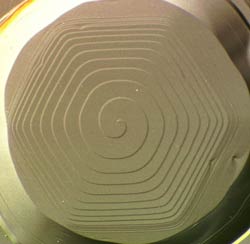Supersolid, with a Twist
The strange quantum phenomenon known as supersolidity occurs when atoms flow without friction through a solid block of helium, possibly along a network of defects extending through an otherwise perfect crystal. In the 20 July Physical Review Letters, physicists find such a flow in computer simulations even when the atoms that make up the defects form a regular pattern, unlike the disorderly arrangement used in previous calculations. The results open a new way of understanding this extraordinary state of matter, which has properties of both solids and liquids.
In 1969, Soviet theorists conjectured that vacancies–missing atoms in a crystal lattice–could lock together at low temperature. This quantum orchestration–similar to what happens in superfluids and superconductors–would let some atoms move unobstructed through the crystal. It was not until 2004, however, that physicists at Pennsylvania State University thought they spied the elusive “supersolid” state. The researchers grew crystals of solid helium under high pressure in a disk-shaped vessel connected to a spring that let it twist back and forth. When they cooled the apparatus below 0.2 Kelvin, the oscillation suddenly sped up, as if some of the mass had disappeared. The researchers concluded that 2 percent of the frozen helium had turned into a superfluid that stayed put as the rest of the twisting crystal slid past.
Later experiments confirmed the effect but found that less of the helium became superfluid in samples with fewer flaws, or “defects,” in the perfect crystalline structure of helium atoms. Most researchers now think that the friction-free flow occurs along defects called grain boundaries–extended border surfaces between differently-oriented crystalline regions. These extended defects act a bit like an internal plumbing system. The orderly arrangement of atoms is disrupted at the grain boundaries, so “the growing opinion has been that supersolids only come from disorder,” says Anatoly Kuklov of the College of Staten Island in New York City. But now he and his collaborators have rescued the idea that superfluid flow can sometimes appear even when atoms are regularly arranged.
The team simulated a helium crystal with around 2000 atoms. They introduced a screw dislocation, in which bonded atoms form a regularly-repeating spiral staircase around a central axis, or core. They found that the core acted like a tube along which some fraction of atoms could flow freely as a superfluid–the lower the temperature, the larger the superfluid fraction. Such a one-dimensional superfluid has no precise phase transition, but a network of such tubes should form an ordinary 3-D superfluid that could explain supersolid observations below 0.2 Kelvin, Kuklov says. But he warns that experimental confirmation of the idea won’t be easy because the high pressure required for solid helium complicates the procedures that would be needed to identify screw dislocations. Still, he believes the experiments are doable.
Seeing superfluid flow in the one-dimensional core is a “paradox,” says Sebastien Balibar of the École Normale Supérieure in Paris, because an orderly arrangement usually inhibits superfluidity. “How could matter show these two competing types of order at the same time?” Still, Alexander Meyerovich of the University of Rhode Island says that if it is correct, “the result is very significant and presents a large step in our understanding of quantum crystals.”
–Michael Schirber
Michael Schirber is a Corresponding Editor for Physics Magazine based in Lyon, France.





